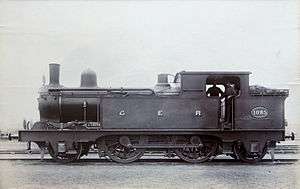GER Class C32
|
GER 1085, one of the condenser-fitted R33 batch in an undated photograph | |||||||||||||||||||||||||||||||||||||||||||||||||
| |||||||||||||||||||||||||||||||||||||||||||||||||
| |||||||||||||||||||||||||||||||||||||||||||||||||
| |||||||||||||||||||||||||||||||||||||||||||||||||
| |||||||||||||||||||||||||||||||||||||||||||||||||
The GER Class C32 was a class of fifty 2-4-2T steam locomotives designed by James Holden and built by the company's Stratford Works between 1892 and 1902. They all passed to the London and North Eastern Railway at the 1923 grouping and received the classification F3.
History
These locomotives were fitted with 17 1⁄2-by-24-inch (444 mm × 610 mm) cylinders and 5-foot-8-inch (1.727 m) diameter driving wheels. They were a tender version of the T26 class 2-4-0s, albeit with a 3-inch (76 mm) shorter coupled wheelbase. They shared the same type of boiler as that class, well as the N31 and later Y14 class 0-6-0s. They were intended for use on long-distance stopping services,[1] and so they were all initially fitted with Westinghouse air brake equipment.
| Year | Order | Builder | Quantity | GER Nos. | LNER Nos. | 1946 No. | Notes |
|---|---|---|---|---|---|---|---|
| 1893 | C32 | Stratford Works | 10 | 1090–1099 | 8090–8099 | 7114–710 | |
| 1893 | O33 | Stratford Works | 10 | 1070–1079 | 8070–8079 | 7121–7127 | |
| 1894 | R33 | Stratford Works | 10 | 1080–1089 | 8080–8089 | 7128–7132 | |
| 1895 | G35 | Stratford Works | 10 | 1060–1069 | 8060–8069 | 7133–7140 | |
| 1902 | D53 | Stratford Works | 10 | 1040–1049 | 8040–8049 | 7141–7150 | |
The R33 and D53 batches had been fitted with condensing equipment from new, but the LNER gradually removed them from all but one locomotive, the exception being an early retirement.
All had survived to pass to the LNER in 1923; the first retirement started in 1936 when 8090 was withdrawn.
Thirty-seven locomotives lasted long enough to be renumbered in the 1946 scheme; fifteen of them became the property of British Railways in 1948, but only three of them lasted long enough to receive their BR number.
| Year | Quantity in service at start of year | Quantity withdrawn | Locomotive numbers |
|---|---|---|---|
| 1936 | 50 | 1 | 8090 |
| 1937 | 49 | 4 | 8069, 8074, 8076, 8098 |
| 1938 | 45 | 8 | 8065, 8073, 8080, 8083, 8084, 8086, 8087, 8091 |
| 1947 | 37 | 22 | 7116/18/21–23/25/29–33/35–38/42/44–48 (ex-8094/96/99/70–73/77/82/85/88/89/60/62–64/66/41/43–47) |
| 1948 | 15 | 7 | 7114, 7115, 7117, 7119, 7134, 7141, 7143 (ex-8092, 8093, 8095, 8097, 8061, 8040, 8042) |
| 1949 | 8 | 3 | 7140, 67149, 7150 (ex-8068, 8048, 8049) |
| 1950 | 5 | 4 | 7124, 7126, 67128, 7139 (ex-8075, 8078, 8081, 8067) |
| 1953 | 1 | 1 | 67127 (ex-1079) |
References
- ↑ Baxter 2012, p. 82.
- ↑ Baxter 2012, pp. 82–93.
- ↑ Baxter 2012, pp. 82–83.
| Wikimedia Commons has media related to GER Class C32 / LNER Class F3. |
Sources
- Aldrich, C. Langley (1969). The Locomotives of the Great Eastern Railway 1862–1962 (7th ed.). Wickford, Essex: C. Langley Aldrich. OCLC 30278831.
- Baxter, Bertram (2012). Baxter, David; Mitchell, Peter, eds. British Locomotive Catalogue 1825–1923, Volume 6: Great Eastern Railway, North British Railway, Great North of Scotland Railway, Midland & Great Northern Joint Railway, remaining companies in the LNER group. Southampton: Kestrel Railway Books. p. 82–83. ISBN 978-1-905505-26-5.
- Fry, E. V., ed. (April 1964). Locomotives of the L.N.E.R., part 7: Tank Engines - Classes A5 to H2. Kenilworth: RCTS. pp. 61–64. ISBN 0-901115-13-4.
Further material
- "LNER Class F3 encyclopaedia entry". LNER Society.
